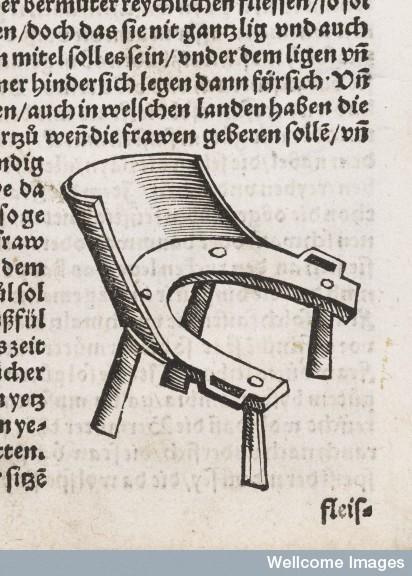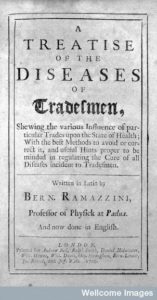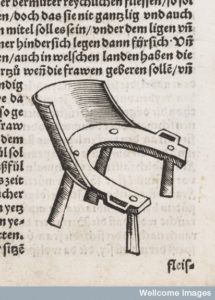

 While doing some research for the book Sara and I are writing on diseases and medicines in the early modern era I came across a book published in 1703 by Italian doctor Bernardino Ramazzini. Sometimes referred to as the father of occupational medicine Ramazzini’s book explores ‘the various influence of particular trades upon the state of health.‘ In the book he includes both nurses and midwives.
While doing some research for the book Sara and I are writing on diseases and medicines in the early modern era I came across a book published in 1703 by Italian doctor Bernardino Ramazzini. Sometimes referred to as the father of occupational medicine Ramazzini’s book explores ‘the various influence of particular trades upon the state of health.‘ In the book he includes both nurses and midwives.
Ramazzini compares midwives to the subjects of his previous chapter the bearers of corpses, and points out that midwives are subject to fewer hazards than those dealing with man’s exit from the mortal world. But the book cautioned ‘they do not always `scrape free when they receive the Birth together with the Flux that comes from the Womb’.
The danger, he claimed, was in part because the Lochia (postpartum bleeding) contained a ‘corruption’ (The book then contains a long digression reciting the various early modern theories about whether or not menstrual blood was toxic and dangerous or a pure substance that nourished the women and her child). This substance ‘undoubtedly tainted with Malignity and Virulency’ dropping onto midwives outstretched hands was problematic. Ramazzini claimed that ‘sometimes their Hands are inflam’d and ulcerated by the sharp corrosive Matter.’
This could have extreme results. The evidence provided in this matter is a case from ‘Fernelius’, the French physician Jean Fernel (1497-1558), in which a midwife ‘by laying a Woman, contracted such Disorders in her Hand, that it corrupted and fell off’. The problem in this particular case was that the mother was ‘pox’d’. Not all midwives were so unprepared. Many, the book claimed, midwives who knew their patients had the pox would ‘wrap their Hands up in Linnen Cloaths, and wash `em often in Water and Vinegar’. to avoid infection.

Credit: Wellcome Library, London
A similar more potent danger was inhaling the ‘noxious Steams’ produced by this pocky blood. Midwives in this situation couldn’t guard against infection because the traditional prophylactics ‘sweet-sented Odors’ would throw their patients into ‘Hysterick Fits’ (for more on this see this previous post on wombs and aromatics).
The contagious nature of venereal disease was well-known, and many medical writers acknowledged that child contracted the disease from their mothers during birth.
Ramazzini next singled out the physical demands of the midwife’s job as a source of potential ill-health. However, in this case English, French and German midwives were thought to be at a distinct advantage because the women they attended gave birth in their beds – providing midwives with easy access. In Italy however women gave birth using ‘perforated Stools’ or birthing stools (like the one in this image). Ramazzini claimed that these stools changed the position of the midwife in relation to the woman giving birth, meaning that,
Midwives are oblig’d to sit bending forward with expanded Hands waiting the Egress of the Foetus at the Door of the Matrix [womb], and are so fatigued with Toil and patient Attendance (especially when they wait upon Women of Quality, or such as have hard Labour) that immediatly upon the delivery they run Home quite shatter’d, and curse their Profession
We can see this strenuous posture depicted in this image from Eucharius Rosselin’s Rosengarten [The Rose Garden] from 1513.

So often in the midwifery manuals I have read there is little focus on the midwife’s own health. The focus is always the mother and the child. It is intriguing to see here the perceived jeopardy that midwives were put in by their occupations. The image of the diligent midwife holding strenuous bodily positions and feverishly washing her hands to avoid the venereal taint adds a new dimension to my image of the working lives of these women.
With this post we bid you goodbye for a little while we are now going on a summer break and will be back in October! Have a lovely summer




Louise Bourgeois tells the story of a midwife who spread the pox. As for feverish washing, any kind of washing is a minority sport nowadays. Surveys indicate that ICU staff are among the least washed. 23% of doctors, twice that for nurses. Interestingly, washing usually occurs after seeing the patient, not before.